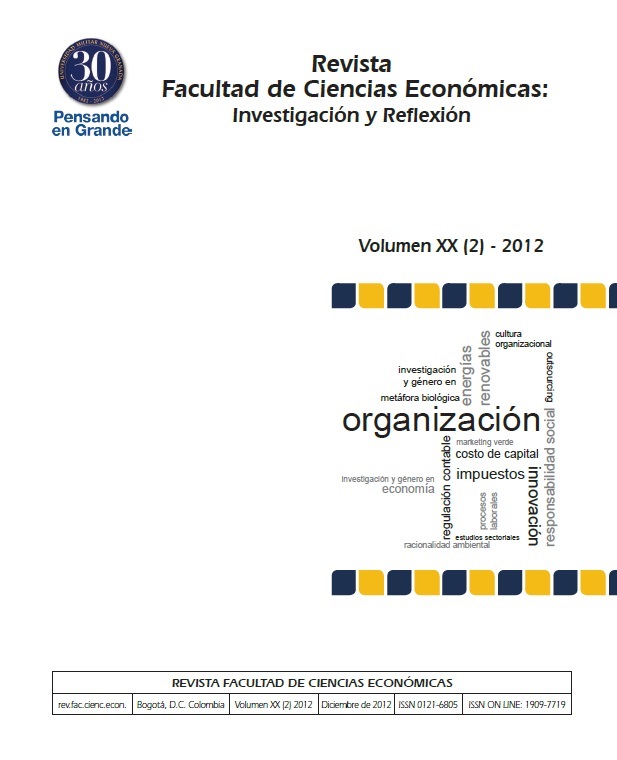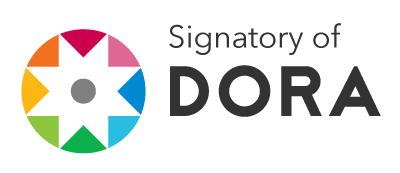Organizational culture: sectoral approximation in Bogotá
Abstract
This research sought to identify the profiles of organizational culture in four productive sectors of Bogotá, and research the association of these profiles with their innovational performance. With the model and survey form of Denison (1998, 2005), a sample of 141 companies which belong to 4 subsectors was made to estimate the sectoral profiles of organizational culture. Contrary to what was expected in the study, there was no evidence of significant differences among general profiles or corporation culture of sectors, although there were differences in the association degrees between innovation and organizational culture variables in each sector. There were differences in the score of organizational culture variables of innovating companies in relation to those less innovating enterprises. Finally, there is statistical association among organizational cultures and innovation characteristics, finding that the discrimination by sectors also explains innovation.Downloads
References
Baker, K. (2004). Organisational culture. Chapter 11. Disponible en:http://www.maxwell.af.mil/au/awc/awcgate/doe/benchmark/ch11.pdf
Becker, G. (1964). Human capital: A theoretical and empirical analysis with special reference to education. New York. Columbia University Press.
Block, P. (1991). The empowered manager: Positive political skills at work. San Francisco. Jossey Bass.
Boyce, A. (2010). Organizational climate and performance: An examination of causal priority. Doctoral dissertation, Michigan State University.
Davenport, T. (1993). Process innovation: Re-engineering work through information technology. Boston. Harvard Business School Press.
Denison, D. (1982). The climate, culture, and effectiveness of work organizations: A study of organizational behavior and financial performance. Doctoral dissertation, University of Michigan.
Denison, D. (1984). Bringing corporate culture to the bottom line. En: Organizational Dynamics, 13: 4-22.
Denison, D. (1990). Corporate Culture and Organizational Effectiveness. New York: Wiley.
Denison, D. (2000) Organisational Culture: Can it be a key lever for driving organisational change? International Institute for Management Development, June.
Denison, D., Haaland, S. & Goelzer, P. (2003a). Corporate culture and organizational effectiveness: Is Asia different From the rest of the world? En: Organizational Dynamics, 33 (1): 98-109.
Denison, D., Haaland, S. & Goelzer, P (2003b). Corporate culture and organizational effectiveness: Is there a similar pattern around the world? En: Advances in Global Leadership, 3: 205-227.
Denison, D., Hooijberg, R., Lane, N. & Lief, C. (2012). Leading Culture Change in Global Organizations. San Francisco: Jossey-Bass/Wiley.
Denison, D. & Mishra, A. (1995). Toward a theory of organisational culture and effectiveness. En: Organisation Science, 6(2): 204-223.
Denison, D. & Neale, W. (1996). Denison organisational culture survey. Facilitator guide. Denison Consulting. Ann Arbor. Michigan.
Denison Consulting (2008). Research Notes. Vol. 2. Disponible en:http://www.denisonconsulting.com/Libraries/Resources/RN_Organizational_Culture_and_Innovation_200812.sflb.ashx
Fey, C. & Denison, D. (2003). Organisational Culture and Effectiveness: Can American Theory Be Applied in Russia? Working Paper 598. Disponible en: http://wdi.umich.edu/files/publications/workingpapers/wp598.pdf
Flynn, F. & Chatman, J. (2001). Strong Cultures and Innovation: Oxymoron or Opportunity? En: Cooper, C. & Cartwright, S. & Earley, P. (Eds.) International Handbook of Organizational Culture and Climate: 263-287. West Sussex, UK: John Wiley & Sons Limited.
Gisbert, M. (2005). Creatividad e Innovación en la Práctica Empresarial. Madrid. Fundación Cotec para la Innovación Tecnológica. Colección Estudios.
Gómez, I. & Ricardo, R. (2009) Similarities and diferences existing in cultural profiles of colombian organizartions of higher and lower performance. En: Revista Facultad de Ciencias Económicas: Investigación y Refexión, Universidad Militar Nueva Granada, Vol. XVII (1).
Gregory, B., Harris, S., Armenakis, A. & Shook, C. (2009). Organizational culture and effectiveness: A study of values, attitudes, and organizational outcomes. En: Journal of Business Research, 62 .
Hamel, G. & Prahalad, C. (1994). Competing for the future. Boston. Harvard Business School Press. Disponible en:http://www.hsfulda.de/fileadmin/Fachbereich_SW/Downloads/Profs/Wolf/Studies/colombian/colombian.pdf
Lawler, E. (1996). From the ground up: Six principles for building the new logic corporation. San Francisco.
Jossey Bass. Likert, R. (1961). New patterns of management. New York. Mc-Graw Hill.
Linnenluecke, M. & Griffiths, A. (2009) Corporate sustainability and organizational culture. En: Journal Of World Business, 45 (4): 357-366.
Martensen, A. & Dahlgaard, J. (1999). Strategy and planning for innovation management-supported by creative and learning organizations. En: International Journal of Quality and Reliability Management, 16 (9): 878-891.
Mintzberg, H. (1987). Crafting strategy. En: Harvard Business Review, 65, 66-75.
Mobley, W., Wang, L. & Fang, K. (2005). Organisational culture: measuring and developing it in your organisation. En:Harvard >Business Review China, March: 6.
Morcillo, P. (2007). Cultura e innovación empresarial. España. Thomson.
Ogliastri, E. (1998). Culture and organizational leadership in Colombia. En: Organisation Science, 14 (6): 686-706.
Ohmae, K. (1982). The Mind of the Strategist. McGraw-Hill, New York.
Oviedo, H. & Campo, A. (2005). Aproximación al uso del coeficiente alfa de Cronbach. En: Revista colombiana de psiquiatría, Asociación Colombiana de Psiquiatría, XXIV (4): 572-580.
Saffold, G. (1988). Culture traits, strength, and organisational performance: Moving beyond "strong" culture. En: Academy of Management Review, 13(4): 546-558.
Schein, E. (2010) Organizational Culture and Leadership (4th ed.). San Francisco: Jossey-Bass/Wiley.
Schein, E.H. (1985). Organisational culture and leadership. San Francisco. Jossey-Bass.
Schumpeter, J. (1942). Capitalismo Socialismo y Democracia. Buenos Aires, Editorial Claridad.
Senge, P. (1990). The fifth discipline: The art and practise of the learning organisation. New York. Doubleday/Currency.
Smerek, R. & Denison, D. (2007). Social capital in organizations: Understanding the link to firm performance.Academy of Management Best Paper Proceedings.
Spreitzer, G. (1995). Psychological empowerment in the workplace: Dimensions, measurement, and validation. En:Academy of Management Journal, 38: 1442-1465.
Stalk, J. (1988). Competing against time: How time-based competition is reshaping global markets. New York. Free Press.
Vence, X. (2007). Crecimiento y políticas de innovación: nuevas tendencias y experiencias comparadas. España. Ediciones Pirámide.
West, M. & Farr, J. (1990). Innovation and creativity at work: Psychological and organizational strategies. Chichester: Wiley.











